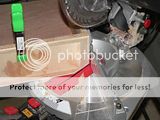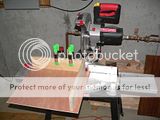Hello all,
I've just finished cutting most of the wood for a pair of Sachiko's. I've cut everything but the alternate deflectors.
I am using a sliding miter saw and trying to figure out how to cut a 66deg angle b/c the saw only has 0-45 deg for cuts.
I decided that if I could turn the board on its end and run the 24 deg cut through it that it should make a 66 deg cut, but I don't really know how to use my saw that way.
How would you make a 66 deg angle?
I may scrap that and just make the stepped deflectors, but I thought I would ask about it first.
Also, what are the possibilities for filling the void behind the alternate deflectors?
Thanks,
-Andy
I've just finished cutting most of the wood for a pair of Sachiko's. I've cut everything but the alternate deflectors.
I am using a sliding miter saw and trying to figure out how to cut a 66deg angle b/c the saw only has 0-45 deg for cuts.
I decided that if I could turn the board on its end and run the 24 deg cut through it that it should make a 66 deg cut, but I don't really know how to use my saw that way.
How would you make a 66 deg angle?
I may scrap that and just make the stepped deflectors, but I thought I would ask about it first.
Also, what are the possibilities for filling the void behind the alternate deflectors?
Thanks,
-Andy
For filling voids, dried silver-sand, lead shot, antibacterial cat litter etc. are common choices. The cat litter is probably the safest bet.
Sand blasting grit works well too.
For the angles I actually used a surface planer - it wasn't perfect but sealed ok.
Fran
For the angles I actually used a surface planer - it wasn't perfect but sealed ok.
Fran
I am using a sliding miter saw and trying to figure out how to cut a 66deg angle b/c the saw only has 0-45 deg for cuts.
How would you make a 66 deg angle?
I make mine on a miter saw with a jig. Others can suggest even better ways using other tools (router or table saw).


http://i69.photobucket.com/albums/i43/Ty_Bower/Buschhorn/P1140018.jpg
http://i69.photobucket.com/albums/i43/Ty_Bower/Buschhorn/P1140015.jpg
Thanks for the replies. Cat litter seems like a great choice.
Ty, that first link is great, but I'm not sure if I can cut the 11.75 '' board on it's end like that with my saw.
-Andy
Ty, that first link is great, but I'm not sure if I can cut the 11.75 '' board on it's end like that with my saw.
-Andy
access to table saw?
The safest and most accurate method I've found for cutting these acute angles is with tenoning jig. Set the saw blade to cross cut the obtuse bevel with mitre jig, then clamp the workpiece in tenoning jig and align for a perfect 90` to whatever angle the saw is set ( i.e. 24` in this case)
If you're not sure about the accuracy of table saw's blade angle gauge (or the indicator is broken 🙂 , cut a scrap on the mitre saw for reference. It'll take longer to set the angle and align the tenoning jig than to cut all four deflectors. I've used this method countless times, AFAIC the cost of the tenoning jig paid for itself on the first pair of speakers.
Of course, if the board is too wide to cut this way, you could fabricate a sled jig for router table, but that could take longer than building the damned speaker, and the cutting length of router bit might be too short. The other alternative is to start with bevel cut to 45` and go at it with smoothing plane. BTDT - it's nowhere near as much fun as the tenoning jig by the time you've finished number 4.
The safest and most accurate method I've found for cutting these acute angles is with tenoning jig. Set the saw blade to cross cut the obtuse bevel with mitre jig, then clamp the workpiece in tenoning jig and align for a perfect 90` to whatever angle the saw is set ( i.e. 24` in this case)
If you're not sure about the accuracy of table saw's blade angle gauge (or the indicator is broken 🙂 , cut a scrap on the mitre saw for reference. It'll take longer to set the angle and align the tenoning jig than to cut all four deflectors. I've used this method countless times, AFAIC the cost of the tenoning jig paid for itself on the first pair of speakers.
Of course, if the board is too wide to cut this way, you could fabricate a sled jig for router table, but that could take longer than building the damned speaker, and the cutting length of router bit might be too short. The other alternative is to start with bevel cut to 45` and go at it with smoothing plane. BTDT - it's nowhere near as much fun as the tenoning jig by the time you've finished number 4.
Last edited:
The secret to cutting angles more than 45 degrees is cutting the wood standing up.
It will take a few passes and fence adjustments to get it so that it cuts all the way to the tip of the board but it's MUCH faster than making a jig and you don't have to buy anything.
- Set the saw for the complimentary angle. In this case it's 27 degrees.
- Then, scoot the fence very close to the blade so that it's about 2 wood thicknesses away.
- Using another small board as backing against the fence, pinch the two together and slide them through the blade.
It will take a few passes and fence adjustments to get it so that it cuts all the way to the tip of the board but it's MUCH faster than making a jig and you don't have to buy anything.
The secret to cutting angles more than 45 degrees is cutting the wood standing up.
- Set the saw for the complimentary angle. In this case it's 27 degrees.
- Then, scoot the fence very close to the blade so that it's about 2 wood thicknesses away.
- Using another small board as backing against the fence, pinch the two together and slide them through the blade.
It will take a few passes and fence adjustments to get it so that it cuts all the way to the tip of the board but it's MUCH faster than making a jig and you don't have to buy anything.
as click and clack the tappet brothers might say "in your job, is it essential that you have all 10 fingers?"
Unless your saw blade tilts to the left, you'll need to move the fence and cut "left handed". Take the time to clamp/screw a wide piece of scrap to the rip fence for more vertical support, use a backing board taller than the fence, and use clamps or a few wraps of masking tape to hold the two boards together.
Ten fingers is overrated....lol
Mine does tilt to the left though so that's probably why I find it so easy. I'm pretty decent with the saw so it's not that big a deal for me.
Mine does tilt to the left though so that's probably why I find it so easy. I'm pretty decent with the saw so it's not that big a deal for me.
here's the method I've found most accurate:
http://www.vitalstates.org/diy/ariel/jig.jpg
full explanation in the paragraph detailing internal partitioning:
Vitalstates - Ariel
I've found a quicker method is a jig in the band saw....but you obviously need the tools for either of these methods
Ed
http://www.vitalstates.org/diy/ariel/jig.jpg
full explanation in the paragraph detailing internal partitioning:
Vitalstates - Ariel
I've found a quicker method is a jig in the band saw....but you obviously need the tools for either of these methods
Ed
- Status
- Not open for further replies.
- Home
- Loudspeakers
- Full Range
- Sachiko Project - 66 deg Angle